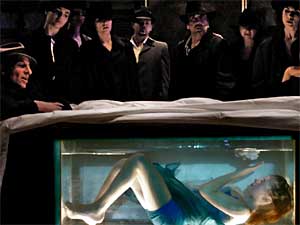|
Audio
Photos
Resources
|
February 18, 2005
 |
| In Theatre de la Jeune Lune's production of Maria de Buenos Aires the emphasis is on great theater as well as great music. (Photo Courtesy of Theatre de la Jeune Lune) |
St. Paul, Minn. — Brenda Harris and Anna Jablonski are rehearsing Gaetano Donizetti's Maria Padilla in the Minnesota Opera's rehearsal space. Their bold, lush voices easily fill the room as they learn the blocking for the scene.
They walk about in large slips over their jeans and sweaters, a shadow of what their costumes will eventually be. They're trying to get used to moving with long skirts and cumbersome petticoats.
Music Director Dale Johnson says you simply can't find a voice locally to perform roles like Maria Padilla, Tosca and Madame Butterfly. So the Minnesota Opera hires top singing talent from all over the country. And it performs with a full orchestra.
"You know many of these great operas were written with the great 18th, 19th, and early 20th century voices in mind," says Johnson. "We try to pay homage to that and to bring the people we think would do justice to those roles. So we try to be musicologically correct."
But meanwhile the local pool of singers is rapidly expanding, and it's finding steady work.
This month alone Theatre de la Jeune Lune is staging Astor Piazolla's Maria de Buenos Aires, the North Star Opera Company is just finishing up its run of Scott Joplin's opera Tremonisha, and Theatre Latte Da is performing Giacomo Puccini's La Boheme. Johnson says he admires the work of these smaller companies, but he doesn't think they're in the same league. He considers them theatrical versions of operas.
"Iif they really want to go and say well I've seen an OPERA, then come to the Minnesota Opera," says Johnson. "But if they want to step their toes in the water go to Caffe Latte Da or whatever it is."
Theater Latte Da artistic Director Peter Rothstein says thanks to MTV, opera has a growing fan-base. Kids grow up watching stories told though music. He says theaters are trying to milk this budding new audience. In addition to directing his own musical theater company, Rothstein stage directs touring shows for the Minnesota Opera and other major opera houses. But dollar for dollar he thinks his little company's production of La Boheme offers a richer experience.
"I think the piece is about vulnerability, it's about choosing to fall in love versus acting out of fear, and I think it's hard for your actors to be vulnerable when they have a 90 piece orchestra literally underneath them," says Rothstein.
Rothstein has pared down the orchestra to an accordion street band. In one scene, art symbolically rises to power as two men fight with paintbrush and palette instead of sword and shield.
Rothstein says he could never pull that off in an 1800-seat house. It's too subtle, not flashy enough. Rothstein's production of La Boheme uses young local singers. He says professional opera singers often sing a role a half-dozen times or more, which makes it hard for them to approach the part with new ideas.
Theatre de la Jeune Lune is all about new ideas. In Maria de Buenos Aires, sisters Jennifer Baldwin-Peden and Christina Baldwin play Maria and her ghost. They wrap themselves around one another as they sing in a sensual tango twister as complex as the music.
Artistic Director Dominique Serrand says for him opera is such a sensual experience that he's stunned by how many operas feature singers just standing and singing.
"I've been often to those kinds of operas and it's amazing to see people sit and the first thing they do is close their eyes," says Serrand.
Serrand says those people are going to hear a live musical performance. But he thinks they're actually missing out. He says he's offering great theater and stunning visuals. Serrand knows his opera's music might not match that of the Minnesota Opera, but he doesn't care.
"This is about the sentiments, this is about being very close to a singer, this is about true emotions," says Serrand. "So the reduction in a way makes it more important and more heartfelt."
Serrand says Jeune Lune is a theater company, so when it chooses to produce an opera, it's because it really loves the work, not because it has to.
Jennifer Baldwin Peden says she prefers to work with Jeune Lune and other small theaters, because she has more of a say in the development of the show. But there's a part of her that loves the chance to sing with a full orchestra:
"It's like riding a thoroughbred horse," says Baldwin-Peden. "It's very muscular, right under you, and its surging away and 'Oh my gosh! Can I hang on?'"
Baldwin-Peden compares the large opera houses to steamships, the small houses to sailboats. While one is impressive and boasts more raw power, the other is more agile and flexible, and can take greater risks.
Her sister Christina Baldwin says she wishes people didn't lump big house opera productions and small house productions together in the same group. In fact she thinks they should have different names for what they do, if only so people can get the definitions clear.
"Because I love to go see big opera, but I'm going to it knowing consciously that this is something else and what I do is another thing and I think it's unfair to compare the two," says Baldwin.
On that point, both the small and large opera houses appear to agree.







